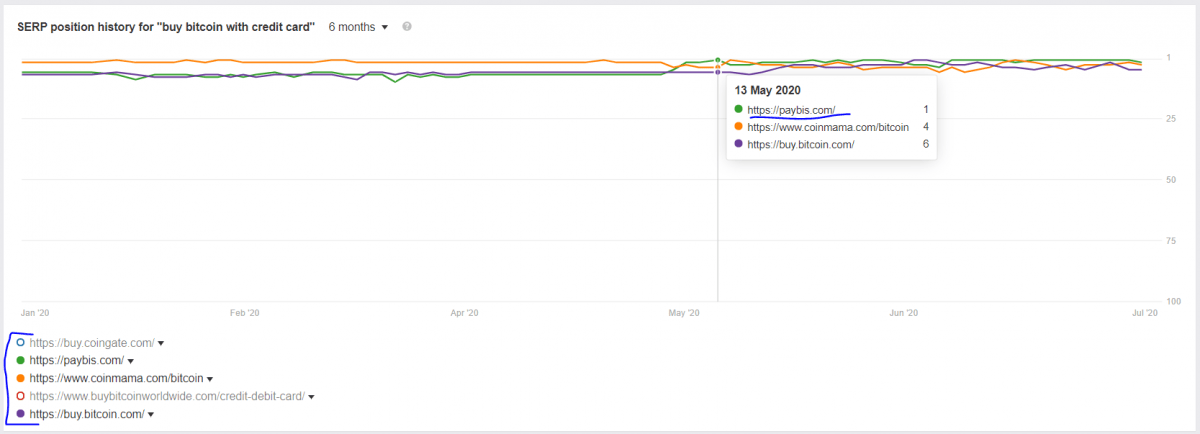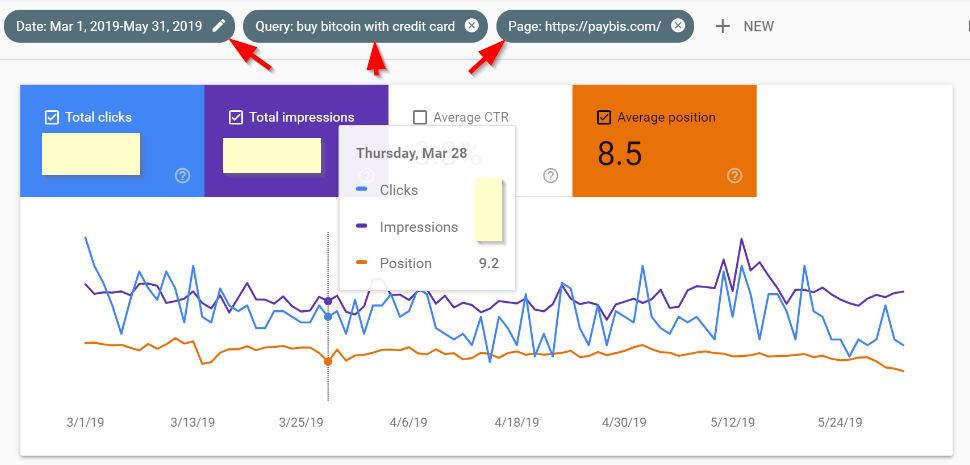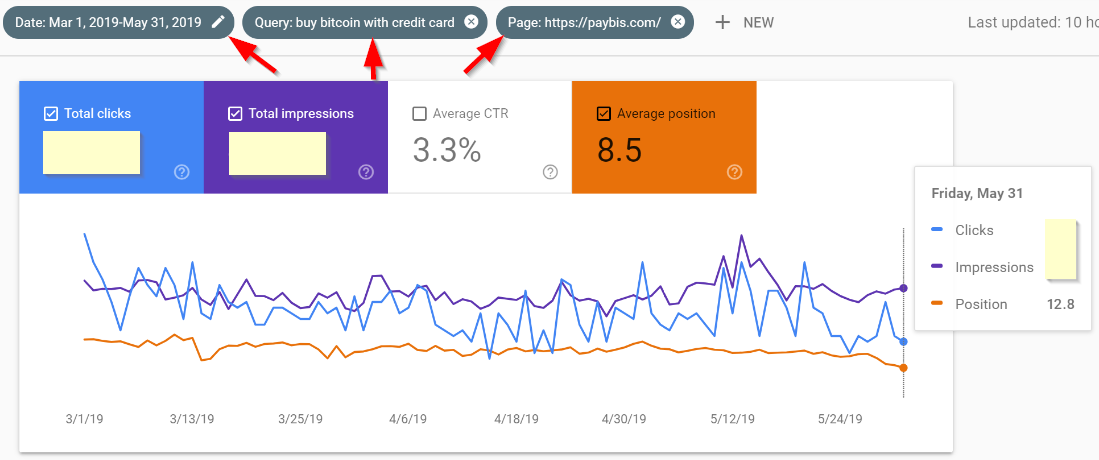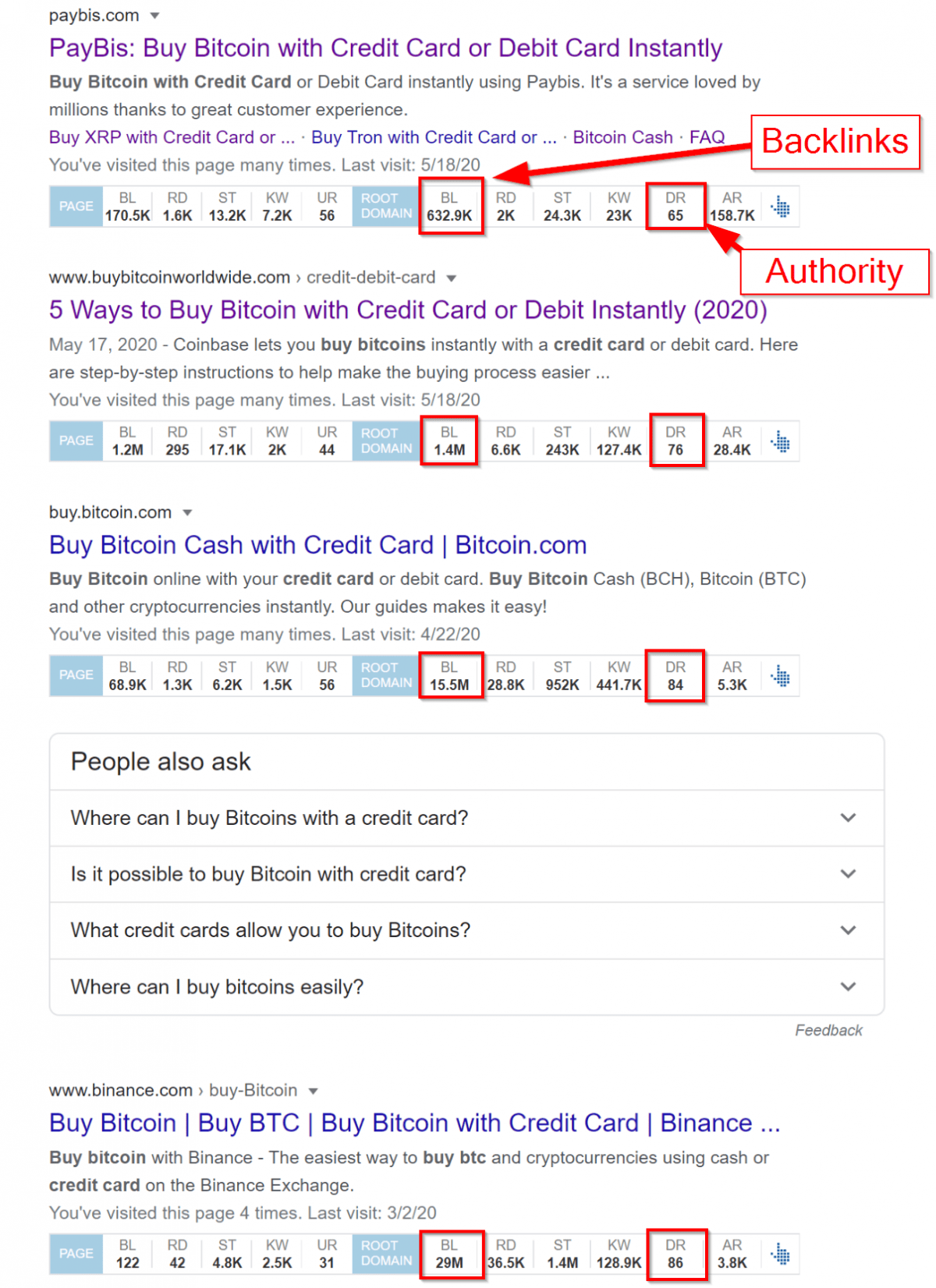We did it!
After 1.5 years of pure SEO wizardry and 954 new (high-quality) backlinks we managed to rank our client’s page No. 1 for their main keyword (which had super high competition).
How?
That you will find out in this article.
But…
Before I showcase the details and learnings that I came across during this period, here’s exactly what we managed to achieve.
What was done
90% of the time, you try to rank 1st (or top-3, or top-10) for your main keyword and it seems like an uphill battle.
You try…
..and then try some more..
But it doesn’t happen.
You are lucky to see at least a tinny bit of progress but most of the time – there is none.
Therefore, a strategy that can produce results of this extent is something I wanted to share with everyone.
Here’s exactly what we managed to do
We ranked our client’s page No.1 for “buy bitcoin with credit card” keyword:

Here are 3 facts about the keyword:
- It’s difficulty is “super hard”
- You would need ~235 backlinks just to get on the first page
- There are ~25,000 people globally searching for this keyword each month
So, what? 😀

Let me put that into perspective.
Because if you are not related to SEO, you might have no idea what I am talking about.
Here’s how ranking for our keyword compares to ranking 1st for the following keywords:
In fact, ranking for these keywords would be a piece of cake when compared to “buy bitcoin with credit card” metrics.
Now you got the picture..
And here’s the magnificent achievement.
After all the hard work, sweat, tears, and whatever else comes out of SEO experts trapped in office..
…we did it:

And our client’s page is ranking 1st for several months:

This means that we outranked pages:
- With a lot higher authority,
- With a lot more backlinks,
- And with a lot more content.
As you can see there is not a single indicator at which our client’s page is ahead of competition.
But still we are ranking first.
If you are wondering “How?“.
Great.
1.5 years ago I would also be baffled.
But now, I can share exactly what we did – so you can do it as well.
So, let’s dig in and I will explain how we got ahead of the competition 😉
How we ranked first for “Super Hard” keyword
So, this is where we started.
Our client was ranking at the end of the 1st page on a good day:

And at the beginning of the 2nd page on a bad day:

As you can see, the position was fluctuating from ~8.5 and 9.2 to all the way down to 12.8.
And what’s important to note – going from end of the 1st page to the 1st position on Google is way harder…
…then increasing the rankings from 40th-60th position to beginning of the 2nd page.
That’s a fact 😉
Having said that…
Usually, I would never promise that I can rank a page 1st for this kind of keyword.
Never.
But our client knew that this won’t be easy, it will take time, and obviously resources.
As our expectations were aligned, we got to work.
And we started putting together the strategy to accomplish what needs to be done.
When starting forms scratch it’s important to follow a structure that works and answer all the questions that are not clear at the beginning.
SEO research to create the plan of action
Throughout the years we have developed a system of how we carry out research and this is what works for us:
- SEO Audit – this is where we start.
- Technical audit:
- This includes everything that’s behind the scenes (front-end):
- Just to name a few – redirects, auditing crawl budget, HTTP/S issues, load time, mobile issues, which pages to de-index, and even schema markups (Jason-LD).
- This includes everything that’s behind the scenes (front-end):
- On-page SEO audit:
- We audit Titles, URLs, Meta descriptions, and Headline 1
- The main thing we check is if the focus keyword is present in all of these sections.
- *This was added to content strategy once we started the execution.
- We audit Titles, URLs, Meta descriptions, and Headline 1
- Then, it’s important to prioritize issues based on the amount of time it takes to fix them and the impact they have on traffic or backlinks.
- Technical audit:
- Content strategy – analysis of content that’s on the site and how it can be improved, as well as list of topics that are missing from each post and that need to be added.
- What content is on the page?
- What’s ranking well and what is not?
- 4 things we check – low CTR pages, high Click keywords, high impression keywords with no clicks, and if page matches the search intent.
- What’s ranking well and what is not?
- Every content strategy should start with competitor research and should answer 3 simple questions:
- What’s their top content in terms of traffic?
- What’s their top content in terms of backlinks?
- Can we compete and create better content?
- Next, it’s important to understand what content you can actually afford to create:
- Here’s why – it doesn’t make sense to create a 2,000-word article when top-5 pages have an average of 4,000-word posts.
- The content strategy need to be made according to budget and necessary outcome:
- If the goal is to get more backlinks – linkbait content should be prioritized.
- If the goal is to get more traffic – content that generates traffic should be prioritized.
- The content strategy need to be made according to budget and necessary outcome:
- The goal is to find low competition topics, where lower authority pages (than ours) are ranking first on Google.
- Next, armed with all the necessary info, the content strategy should include 2 things:
- Improvements for existing posts,
- and new content that will be created based on the target (backlinks and/or traffic).
- Here’s why – it doesn’t make sense to create a 2,000-word article when top-5 pages have an average of 4,000-word posts.
- What content is on the page?
- Link-building – analyze how many backlinks need to be added each week.
- We start by answering a few very important questions:
- What’s the average Domain Authority, Domain Rating, and Alexa Rank of our top-10 competitor domains?
- What’s the average Page Authority, URL rating, and the number of backlinks top-10 pages have?
- How many links they are getting per week, per month, and in the last 6 months?
- What do we need to do to beat the competition?
- Next, we conclude on how many backlinks we need to get each week and what link-building strategies we need to use to hit the targets:
- In our case, this is how we distributed our link-building efforts:
- 50% – targeting backlinks from similar pages
- 20% – guest posts
- 20% – reviews
- 5% – infographics
- 5% – other strategies
- In our case, this is how we distributed our link-building efforts:
- We start by answering a few very important questions:
- SEO strategy – this is the part where all the research comes together.
- Tasks were assigned priorities, the schedule of execution was created, and each item was assigned to the right person.
- Execute, analyze, and improve
- No strategy will work forever.
- In most cases, it will change every ~3 months.
- So, it’s important to analyze which link-building campaigns produced the most backlinks, which content gets the most traffic and/or backlinks.
- And then focus on what’s working the best.
So, this is the structure we follow and some of the questions we answer before we can get to the “execution part”.
For every website, the findings will be different and where the time will be spent will change from business to business as well as will depend on the end goal.
So you never know what are the things you will need to focus on.
In our case, it was very clear and here were the things we defined as the focus-areas:
- SEO improvements
- Content Creation
- Backlinks
And that’s exactly what we did.
Plan of action and execution
We were able to break-down our research into 3 main areas of improvement and here were our main takeaways:
- SEO improvements – after SEO audit and analyzing Google updates, we prepared an extensive list of things that needed to be implemented on the site.
- Content – When we started there were a handful of articles but competitors had an average of 1,000+ articles that were bringing traffic and backlinks.
- On top of that, existing content was not ranking well and user intent was not clear for most of the content that was on-site.
- Backlinks – the top competitors were getting an average of 43 backlinks per week (when looking at the top-10 companies for the period of 6 months). So, we needed to beat them and get at least 60 backlinks per week.
- Our research also revealed that the pace at which our client and competitors were losing backlinks was nearly the same – so this metric was discarded from further considerations.
- In other cases, this might be an important metric to include.
- Our research also revealed that the pace at which our client and competitors were losing backlinks was nearly the same – so this metric was discarded from further considerations.
So, those were the things we focused on and here’s exactly what we did.
SEO improvements
This actually was the easiest part.
All we needed to do is fix SEO issues and implement whatever Google came up with.
Having said that, the fact that the client had ~90+ product pages in 8 different languages, made things a bit more complicated.
So, things like adding alt tags to 1000+ images was not a priority.
Instead, we focused on the following things:
Fixing technical issues
Technical issues, if prioritized properly, can take very little time to solve and can give massive boost in traffic.
- Auditing the redirects – we cut all multiple redirects for every page. In total there were 3,000+ redirects to review and fix.
- Site structure and crawl depth – we made sure it is possible to access 100% of all the important pages in 3 clicks or less.
- HTML sitemap is an easy solution for websites were changing site’s structure is too time-consuming.
- HTTPS and HTTP issues – all the pages that show up when running a Google search – site:yourwebsite.com inurl:http://yourwebsite.com, were redirected to HTTPS version.
- Index Management – pages that are not important were deindexed and we made sure robots.txt, sitemap, and internal do-follow & no-follow links are updated properly.
- Pro tip – If you don’t want the page to be indexed, it shouldn’t be on sitemap and internal links should be no-follow.
- 4xx and internal URL errors – all broken pages were fixed and redirected.
- No response external & internal link issues – all links on the page should lead somewhere so if external/internal links are leading to 404 or 301 pages, that needs to be fixed.
- Page speed – Google page speed insights give a very good idea of what issues should be fixed but here’s where it’s important to have a good software developer on the SEO team.
- Mobile issues – Google Search Console shows all the mobile issues so keeping this number at 0 is very important.
- And less important issues:
- Problems with pagination (one of Google updates)
- Soft 404 errors
- Robots.txt and XML sitemap
Implementing Google’s recent updates
This was an important aspect of all the issues we had to fix mainly because Google is so keen on releasing new things sites should have.
So, we reviewed what each site should have, filtered what’s important, and here’s what we implemented:
- AMP – no we did not implement this for our product/service pages.
- AMP was implemented for our WordPress blog (only).
- Because when looking at time vs. return – it’s too much hustle
- Page speed – this is an on-going process (that’s why added twice :D)
- Mobile-first index – making sure the client’s page is beautiful on the mobile and super easy to use
- Schema markups – all relevant schemas were added to our page
In short, these were some of the most important issues we focused on.
Content creation and optimization
Here our focus was to optimize the existing content and create more content for the newly created product pages (to increase traffic) and write new blog posts (to get more backlinks).
What captures what we did is the following line:
There is no need to create new content when you can optimize the old one and creating new content makes sense only if what you create is better than what’s already out there.
So, that’s exactly what we did.
Content optimization for existing content
Content is the backbone of SEO and if there are issues with existing content – that needs to be fixed ASAP:
- Keyword cannibalization – In several instances, we saw traffic to drop because we created a page with similar keywords that serve a similar intent. This was something that took a lot of time to fix and make it just right.
- In essence, it’s important to monitor Google Search Console every time a new page is released to check if it doesn’t cannibalize existing pages.
- Optimizing existing content – every time we optimize articles and product pages we look at 4 indicators:
- Keywords with the most clicks – we checked if SEO snippet and Headline 1 include this keyword.
- & if the top keywords are visible within the content.
- Pages with the lowest CTR – if CTR is low, it’s a good indicator that the content needs to be optimized.
- Keywords with the highest impression count but ~0 clicks – if there are such keywords, it means that people find the page but the intent is not right. So, new content needs to be created to cover these topics (in some cases).
- Search intent – we paid a lot of attention to make sure transaction pages include mainly transactional keywords (80-90%) and that educational content doesn’t rank for transactional keywords.
- Keywords with the most clicks – we checked if SEO snippet and Headline 1 include this keyword.
- Thin content – for top pages it’s a massive issue, for less important pages there is no need to write additional content (that’s a waste of time).
- Pro tip – create content that covers the topic in-depth and is 10-30% longer than the top content (given you have done keyword research the way I explain in the next section) but excels at on-page optimization.
- SEO snippet – this was a pain to fix because the client had 97+ product pages that were translated into 8 different languages (including Korean and Arabic). So, validation and making sure that each title, meta description, and Headline 1 have the necessary keywords wasn’t easy.
- And less important issues:
- Duplicate content on-site – as we came to discover it’s not a big issue if you use canonical tags the way Google intended them to be used.
- In our case, there is no way, we can write unique content for 97+ pages when the products are so similar.
- Duplicate content off-site
- This is an issue only when the page who’s taking content from your site, ranks better than your page. In most cases, Google is smart enough to see when that’s happening and wasn’t a major issue for us.
- Image Optimisation – we cut images down to the necessary size (if the Px frame on the site is 1920×1080 there is no need to use an image that’s 3 times bigger)
- Duplicate content on-site – as we came to discover it’s not a big issue if you use canonical tags the way Google intended them to be used.
New content creation (blog posts & product pages)
It’s never easy to create content that ranks on first spots of Google.
But we finally cracked the mystery.
And we are not using Keyword Difficulty indicators – that’s useless.
Instead, we use only 3 metrics to decide if it’s worth creating the content.
So, here’s how we created content that ranks 90% of the time on the 1st page:
- Search volume – for obvious reasons we want to know how many people search for each keyword on monthly basis.
- In this case, less might be more and not always more is better.
- Usually, we aim for keywords with search volume less than 1,000 (for product pages it’s more).
- For site’s with authority that is lower than 50-80% of other competitors, it’s important to search for keywords that match the Golden Keyword Ratio:
- For all keywords we checked how many other sites have our keyword in the title – to do that, we searched for “allintitle:the focus keyword” and checked how many results we can see on Google.
- This allows us to see how many pages have optimized their sites for this keyword.
- Then we divide Allintitle count with the Search Volume (given it’s no bigger than 1k) = and we get the ratio that for our page should be less than 1 (it took some testing but we figured out what’s the ratio we can rank for)
- For instance, for new pages the ration should be less than 0.25.
- For all keywords we checked how many other sites have our keyword in the title – to do that, we searched for “allintitle:the focus keyword” and checked how many results we can see on Google.
- Lastly, we check what’s the average DA and DR as well as how many backlinks each of the top-10 pages that rank on Google has.
- As a rule of thumb, the average DA & DR should be lower than yours (and there should be at least 1 page on SERPs that’s completely new).
- When it comes to backlinks – ideally, pages should have 0-5 backlinks. If you can get more backlinks easily, aim for the number of links that you usually get for your articles.
Armed with this info for each keyword, we put together the topics we want to cover for the blog and product pages.
Next, we shape each topic into article that gives readers all the info they might need.
To do that, here’s what comes next:
- Selecting a focus keyword – after the first step, we sort pages by Keyword Golden Ratio and take the keywords with lowest number (given the fact they match our other criteria).
- Then we find as many LSI keywords as possible (also known as synonyms).
- Once that’s done, we check what are similar questions people ask when doing searches for this topic:
- We check AnswerThePublich.
- Use “People also ask” section on Google.
- And check similar articles and their FAQ sections.
- Last but not least, we create the article’s outline, including all the topics we want to cover in the article or product page.
- And start writing.
This should produce content that’s in-depth and ranks very well on Google.
I am talking top of the first page as the best-case scenario.
And the worst-case scenario, the bottom of the first page.
Linkbuilding
Pro tip – to beat your competition, you need to know how many backlinks they are getting each week for ~6 months.
We knew our number.
And our focus was to figure out how to get 60+ backlinks per week.
Scratch that…
60+ high-quality backlinks per week.
At first, this seemed like the mission impossible because when we started our client was getting 1-5 backlinks at any given week.
So, how do you scale link-building from 1-5 backlinks per week to 60+?
It wasn’t easy but here’s what we did.
Linkbuilding strategies we prioritized
We focused on 3 different types of link-building campaigns:
- Fully automated link-building – this is 100% a result of well-executed content strategy and at the end of day, it’s important that this becomes a primary channel of backlinks (eventually).
- Content results in backlinks when it’s extremely well done and ranks at the top of the Google. Then people cannot help but add backlinks your posts.
- 50:50 automated – this is where we spent 50% of our time. We found pages that rank top-10 for our keywords and we would reach out to their backlinks.
- It’s 50% automated because we use outreach tools like NinjaOutreach to handle the emailing part of the process.
- It’s 50% manual because we still need to reply to emails with well crafted and personalized emails.
- Just to give you an idea at what scale we work – each day we send out 400+ emails, from ~20 different campaigns using 4 different email addresses.
- After running the calculations this was the only way to hit the targets.
- 100% manual – here for 1 article or content piece, you get 1 backlink and these are the strategies that we used:
- Finding review and guest posting opportunities, writing the articles and then making sure that they are published.
- Creating infographics and finding sites where to publish them.
- Media files are like products that you exchange for backlinks. The more media files you have, the more backlinks you can get.
- Then we were testing numerous other techniques and executing them week-over-week, or month-over-month – link reclamation, 404 link-building, Google Alert technique (where we reach out to sites that recently mentioned our competitors), and many other strategies.
All-en-all this is what we did to basically 12x our client’s link-building (from 5 to 60 backlinks a week).
Unfortunately, we cannot disclose how many backlinks we got from each of the techniques…
…have to keep that a secret for now 😉
Nonetheless, as of today, we got 954 backlinks that were added since we started working with this client:

So, these are the links that were added manually and come from strategies described in points 2 & 3.
Next, there were the backlinks that we got “automatically”:
Within 30 days those were 300 new backlinks.
Or 70 backlinks in a week (7 days).
So, clearly we hit the target.
And this is just the beginning.
When SEO strategy is well designed, effects keep accelerating.
Wrapping up
So, there you have it – this is how we ranked our client’s page 1st for “buy bitcoin with credit card” keyword.
And hopefully you know how to put together a similar strategy and what it takes to get the necessary results.
As you can see, it takes a lot of work and a lot of resources.
But I hope seeing that we can do it…
…will also help you to believe that it’s possible and you can do it as well.
Best of luck and I hope you found this article helpful 😉















